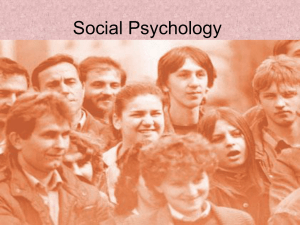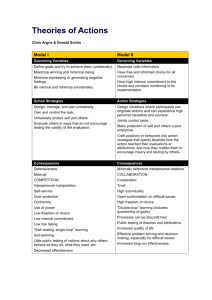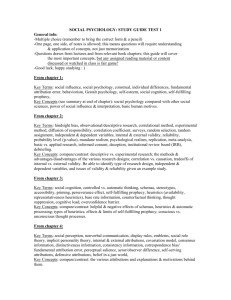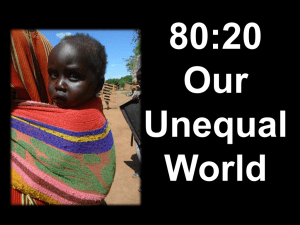Coryn, Antecedents of Attitudes Toward the Poor
advertisement
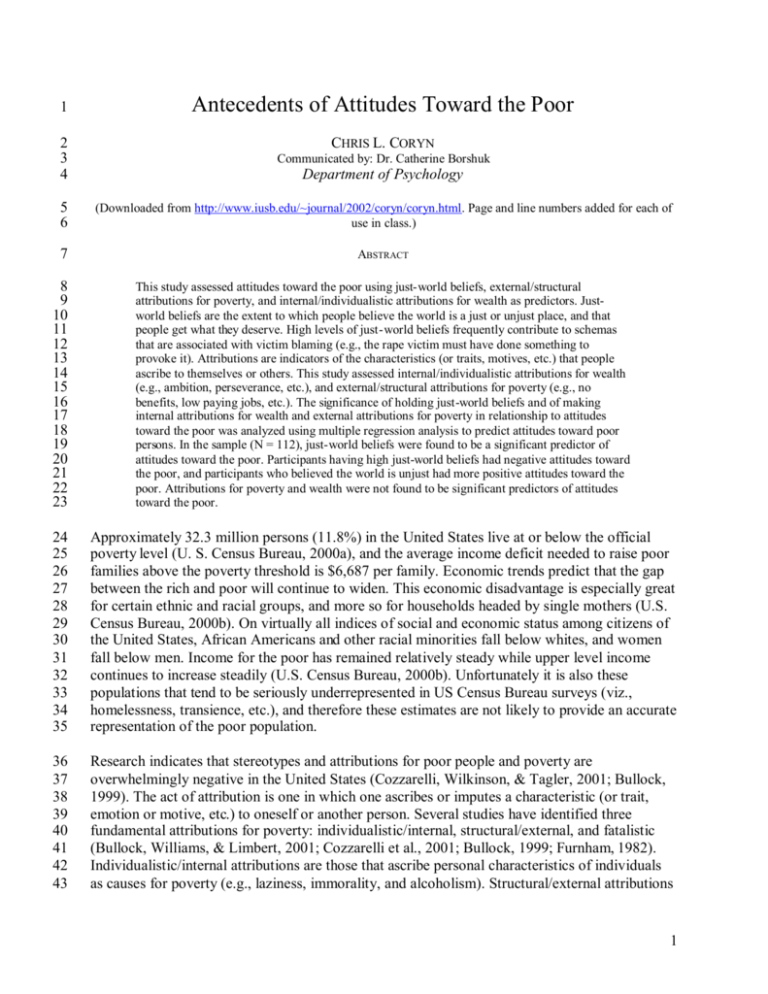
1 Antecedents of Attitudes Toward the Poor 2 3 4 CHRIS L. CORYN Communicated by: Dr. Catherine Borshuk 5 6 (Downloaded from http://www.iusb.edu/~journal/2002/coryn/coryn.html. Page and line numbers added for each of use in class.) 7 ABSTRACT 8 9 10 11 12 13 14 15 16 17 18 19 20 21 22 23 This study assessed attitudes toward the poor using just-world beliefs, external/structural attributions for poverty, and internal/individualistic attributions for wealth as predictors. Justworld beliefs are the extent to which people believe the world is a just or unjust place, and that people get what they deserve. High levels of just-world beliefs frequently contribute to schemas that are associated with victim blaming (e.g., the rape victim must have done something to provoke it). Attributions are indicators of the characteristics (or traits, motives, etc.) that people ascribe to themselves or others. This study assessed internal/individualistic attributions for wealth (e.g., ambition, perseverance, etc.), and external/structural attributions for poverty (e.g., no benefits, low paying jobs, etc.). The significance of holding just-world beliefs and of making internal attributions for wealth and external attributions for poverty in relationship to attitudes toward the poor was analyzed using multiple regression analysis to predict attitudes toward poor persons. In the sample (N = 112), just-world beliefs were found to be a significant predictor of attitudes toward the poor. Participants having high just-world beliefs had negative attitudes toward the poor, and participants who believed the world is unjust had more positive attitudes toward the poor. Attributions for poverty and wealth were not found to be significant predictors of attitudes toward the poor. 24 25 26 27 28 29 30 31 32 33 34 35 Approximately 32.3 million persons (11.8%) in the United States live at or below the official poverty level (U. S. Census Bureau, 2000a), and the average income deficit needed to raise poor families above the poverty threshold is $6,687 per family. Economic trends predict that the gap between the rich and poor will continue to widen. This economic disadvantage is especially great for certain ethnic and racial groups, and more so for households headed by single mothers (U.S. Census Bureau, 2000b). On virtually all indices of social and economic status among citizens of the United States, African Americans and other racial minorities fall below whites, and women fall below men. Income for the poor has remained relatively steady while upper level income continues to increase steadily (U.S. Census Bureau, 2000b). Unfortunately it is also these populations that tend to be seriously underrepresented in US Census Bureau surveys (viz., homelessness, transience, etc.), and therefore these estimates are not likely to provide an accurate representation of the poor population. 36 37 38 39 40 41 42 43 Research indicates that stereotypes and attributions for poor people and poverty are overwhelmingly negative in the United States (Cozzarelli, Wilkinson, & Tagler, 2001; Bullock, 1999). The act of attribution is one in which one ascribes or imputes a characteristic (or trait, emotion or motive, etc.) to oneself or another person. Several studies have identified three fundamental attributions for poverty: individualistic/internal, structural/external, and fatalistic (Bullock, Williams, & Limbert, 2001; Cozzarelli et al., 2001; Bullock, 1999; Furnham, 1982). Individualistic/internal attributions are those that ascribe personal characteristics of individuals as causes for poverty (e.g., laziness, immorality, and alcoholism). Structural/external attributions Department of Psychology 1 1 2 3 4 5 6 are defined as those causes of poverty outside the sphere of the individual control (e.g., social environment, economic conditions, prejudice, and innate economic inequality). Fatalistic attributions are those described as bad luck, illness, fate, etc. Recent research has found that persons in the United States tend to favor individualistic/internal explanations for poverty (Bullock et al., 2001; Cozzarelli et al., 2001; Bullock, 1999), although attributions for poverty are also correlated with sociodemogaphic variations (e.g., age, gender, ethnicity). 7 8 9 10 11 12 13 14 15 There has been surprisingly little research on attitudes toward poverty and the poor as a stigmatized or stereotyped group, despite the available data regarding attitudes and stereotypes toward other disadvantaged groups (e.g., ethnic/racial groups, gays and lesbians). Often these groups suffer stereotyping and/or social stigmas (e.g., ethnic/racial groups, single mothers), and also tend to comprise the majority of the population living at or below federal poverty guidelines or lower levels of living standard (U.S. Census Bureau, 2000a; U.S. Census Bureau, 2000b). For example, poverty rates for 1999 as reported by the U.S. Census (2000b) for Blacks were 23.6%, for Hispanics were 22.8%, for Asians (and Pacific Islanders) were 10.7%, and for single mothers an astounding 53% (U. S. Census Bureau, 2000). 16 17 18 19 20 21 22 23 24 25 26 27 28 Prior research has shown that attitudes toward the poor in the United States tend to be negative (Cozzarelli et al., 2001; Atherton, Gemmel, Hagenstad, Holt, Jensen, O'Hara, & Rehner, 1993). Studies have shown that reporting negative attitudes toward the poor are highly correlated with individualistic/internal attributions for poverty, and positive attitudes toward the poor have been reported as positively correlating with structural/external attributions for poverty (Bullock et al., 2001; Cozzarelli et al., 2001; Iyengar, 1990; Smith & Stone, 1989). Americans typically believe that individuals are responsible for their status in systems of social and economic inequality. There have been suggestions that poverty serves a societal purpose and is a necessary part of our social structure. Persons in low positions are kept there for the benefit of those in high positions (Gans, 1989). To eliminate the poor would be to eliminate the low-wage labor pool, physically dangerous work, temporary work, and undignified and menial jobs. Furthermore, attitudes toward and attributions for poverty have been linked to the belief that the world is a just place where people deserve what they get (Furnham, 1982). 29 30 31 32 33 34 35 36 37 38 39 40 Lerner's Belief in a Just World theory presumes that persons either believe that the world is a just place and that people get what they deserve, or that the world is not a just place and that events occur by chance (Lerner, 1980). Those with high just-world beliefs attribute poverty and other negative circumstances to one's behavior and personal characteristics, concluding that the poor person somehow deserves to be poor. The person's economic status is due to something the person did or failed to do, therefore they deserved it or had it coming. Many studies have correlated just-world beliefs with attributions and/or attitudes with some success (Bullock et al., 2001; Cozzarelli et al., 2001; Furnham, 1982). Although some have questioned the reliability of the psychometric scales measuring just-world beliefs (Lea & Fekken, 1993; O'Conner, Morrison, & Morrison, 1993), most studies have shown significant results with the measurement. And, Furnham (1993) reported that people having high just-world beliefs had more negative perceptions and attitudes toward the poor. 41 42 Research pertaining to poverty and attitudes toward the poor could serve as a catalyst for political policy, education, healthcare, and various other issues concerning this population. 2 1 2 3 4 5 6 7 Poverty continues to be a significant problem in the United States and globally, yet the poor are apt to be devalued and marginalized. Minority group members (e.g., the poor) are objectively worse off than they would be if stereotypes and prejudice did not exist. They suffer psychologically, economically, and physically. Attitudes form quickly and easily, yet resist change. More importantly, the poor are often the victims of categorization, viewed as the social outgroup, and perceived as homogenous; they are all the same (e.g., lazy, immoral, promiscuous, etc.). 8 9 10 11 12 13 14 15 16 Rubin and Peplau (1975) found that just-world beliefs frequently tend to be polar in nature, extending between total acceptance and total rejection of the perception that the world is a just place. Given the previous research, it would seem appropriate to hypothesize that those having higher just-world beliefs will report lower levels of agreement with structural/external attributions for poverty, will report higher levels of agreement with individualistic/internal attributions for wealth, and additionally have more negative attitudes toward the poor. Conversely, those having lower just-world beliefs will report higher levels of agreement with structural/external attributions for poverty, lower levels of agreement with individualistic/internal attributions for wealth, as well as having more positive attitudes toward the poor. 17 Method 18 Participants 19 20 21 22 23 24 25 26 One-hundred and twelve undergraduate students (76 women, 44 men) enrolled in introductory psychology courses at Indiana University South Bend volunteered to participate in this study in order to partially fulfill a psychology course requirement. Seventy-one percent of respondents were White/Caucasian, 22% were Black/African American, 3% were Asian, 1% were Hispanic, and 3% self-identified as ``other''. Fifty-seven percent of participants reported no personal history of public assistance (e.g., food stamps, welfare, or housing subsidies), 42% reported some history of public assistance, and 1% did not know whether they or their immediate family had any history of receiving public assistance. 27 Materials 28 29 30 31 32 33 34 35 36 37 38 Participants were asked to complete a packet of questionnaires. The first part of the questionnaire asked sociodemographic questions (gender, age, ethnicity, and public assistance history). The second questionnaire was Rubin and Peplau's 20-item Belief in a Just World scale (Rubin, & Peplau, 1973). The third questionnaire was a modified 17-item Attributions for Poverty Questionnaire. The fourth questionnaire was a modified 8-item Attributions for Wealth Questionnaire. The Structural Attributions for Poverty and Attributions for Wealth Questionnaires contained selected items from previously tested scales (Bullock et al., 2001). The fifth questionnaire was a 37-item Attitudes Toward the Poor Questionnaire (Atherton et al., 1993). With the exception of the demographic questionnaire, all questionnaires employed fivepoint Likert scales. Participants rated their level of agreement from 1 (strongly agree) to 5 (strongly disagree). 3 1 2 3 4 5 6 7 8 9 10 Belief in a just world. Rubin and Peplau's Belief in a Just World Scale is intended to measure to what extent one believes that the world is a just and fair place where one gets what one deserves. High scorers on this scale have been found to denigrate and blame innocent victims for their plight (Rubin & Peplau, 1973). Twenty statements (e.g., good deeds often go unnoticed and unrewarded, people who meet with misfortune often have brought on themselves) were used to measure the degree to which individuals endorse the Belief in a Just World. Cozzarelli et al., (2001) reported a coefficient alpha of 0.57; although low, it is typical of previously reported values (Lea & Fekken, 1993; O'Conner, Morrison, & Morrison, 1996). Cozzarelli et al., (2001) reported moderate agreement with just-world beliefs (M = 3.63, SD = 0.41), on a seven-point Likert scale. 11 12 13 14 15 16 17 Attributions for poverty. The 17-item Attributions for Poverty Questionnaire was adapted from a scale previously developed and tested by Bullock et al., (2001). Scale items were selected to assess structural attributions for poverty (e.g., low paying jobs with no benefits, prejudice and discrimination in hiring and promotion). Structural attributions are those outside the sphere of individual control (e.g., social environment, economic conditions). Bullock et al., (2001) reported a coefficient alpha of .91, with (M = 4.85, SD = 0.90), on a seven-point Likert scale, for structural attributions for poverty. 18 19 20 21 22 23 Attributions for wealth. The 8-item Attributions for Wealth Questionnaire was adapted from Bullock et al., (2001) 21-item Attributions for Wealth Questionnaire. The 8 items were selected from the original 21-item questionnaire to assess individualistic attributions for wealth (e.g., ambition and personal drive, hard work and perseverance). Bullock et al., (2001) reported a coefficient alpha of 0.82, with (M = 4.98, SD = 0.84), on a seven-point Likert scale, for individualistic attributions for wealth. 24 25 26 27 28 29 30 Attitudes toward the poor. Attitudes Toward the Poor were assessed using the 37-item scale developed by Atherton et al., (1993). The Attitudes Toward the Poor Questionnaire contained statements that reflected both positive (e.g., poor people are discriminated against) and negative (e.g., poor people create their own difficulties) attitudes toward the poor. Positive items were reverse scored. Atherton et al., (1993) reported Cronbach's alpha as 0.93, and the split half reliability as 0.87. Factor analysis concluded that the instrument was a single-factor scale (Atherton et. al., 1993). 31 Procedure 32 33 34 35 36 37 38 39 Participants were recruited using posted research announcements, announcements on Indiana University South Bend introductory psychology web sites, and announcements at introductory psychology classes. Participants reported to Indiana University South Bend classrooms and psychology research rooms in groups of 20-25. Data collection took place over a two-week period from October 4, 2001 to October 17, 2001. Participants were told that attitudes toward a variety of social groups were being investigated. Participants took 15-30 minutes to complete the questionnaire packets. After completing the questionnaire packet, participants were debriefed and informed that attitudes toward the poor were being investigated. 40 Results 4 1 Scale Validation 2 3 4 5 Internal reliabilities were analyzed using Cronbach's index of internal consistency for the sample (N = 112) to validate the Belief in a Just World Scale (a = 0.95), the Attributions for Poverty scale (a = 0.95), the Attributions for Wealth scale (a = 0.93) and the Attitudes Toward the Poor scale (a. = 0.98). All measures were above the adequate range. 6 Descriptive Findings 7 8 9 10 11 12 13 14 In this sample, attitudes toward the poor were, on average, moderately positive (M = 3.13, SD = 0.75) (see Table 1). Just-world beliefs were on average, relatively neutral (M = 2.99, SD = 0.74), although scores were widely dispersed, with higher scores indicating stronger beliefs in a just world. External attributions for poverty (M = 3.22, SD = 0.80) were moderately positive, with higher scores indicating agreement with structural (e.g., discrimination, and lack of child care) attributions for poverty. And, attributions for wealth (M = 3.78, SD = 0.73) were moderately high, indicating agreement with individualistic (e.g., ambition, and intelligence) attributions for wealth. 15 16 Table 1: Summary of Belief in a Just World, Attributions for Poverty, Attributions for Wealth, and Attitudes Toward the Poor Min Max Belief in a just world 1.0 M SD Potential Range 4.85 2.99 0.744 1-5 Attributions 1.05 4.88 3.21 0.80 for Poverty 1-5 Attributions 1.5 for Wealth 5.0 3.78 0.73 1-5 Attitudes towards the 1.16 poor 5.0 3.12 0.74 1-5 17 Correlations among Constructs 18 19 20 21 22 23 24 Correlational analysis revealed a number of relationships between the constructs (see Table 2). Higher just-world beliefs correlated negatively with attitudes toward the poor (see Figure 1), were negatively associated with structural attributions for poverty, and were positively associated with agreement for individualistic attributions for wealth. Structural attributions for poverty were negatively correlated with individualistic attributions for wealth, and positively correlated with attitudes toward the poor. Individual attributions for wealth were negatively associated with attitudes toward the poor. All correlations were significant at the p < 0.001 level. 5 1 2 3 4 5 6 Figure 1: Correlation Between Belief in a Just World and Attitudes Toward the Poor Table 2: Correlations Between Belief in a Just World, Attributions for Poverty, Attributions for Wealth, and Attitudes Toward the Poor 1. 1. Belief in a Just World 2. Attributions for Poverty 3. Attributions for Wealth 4. Attitudes Toward the Poor 7 8 9 2. 3. 4. - -0.612** 0.522** -0.756** - -0.502** 0.484** - -0.433** - Note: Correlation is significant at the 0.01 level (1 - tailed). Regression Analysis 6 1 2 3 4 5 6 7 8 9 Multiple regression analysis was conducted to assess how well just-world beliefs, attributions for poverty, and attributions for wealth predicted the criterion variable, attitudes toward the poor (see Table 3). With all three predictor variables entered simultaneously, the model was significant, F(3, 108) = 48.465, p < .001. And over half (R2 = 0.574) the variance was accounted for by the three predictor variables. Individual coefficients assessed how well each alone predicted the criterion variable. Belief in a Just World was the strongest predictor of attitudes toward the poor ( = -0.719, p < 0.0005). Attributions for poverty and attributions for wealth did not produce any significant effects. As expected, stronger just-world beliefs predicted more negative attitudes toward the poor. 10 11 Table 3: Summary of Multiple Regression Analysis for Variables Predicting Attitudes Toward the Poor Variable B Belief in a just world -0.722 SE B 0.084 -0.719* Attributions for Poverty 1.851e-02 0.077 0.020 Attributions for Wealth -4.853e-02 0.078 -0.047 12 13 Note: R2 = .574 . * p < .0005 14 Discussion 15 16 17 18 19 20 21 22 The results of this study supported the proposed hypothesis; those who scored high on the Belief in a Just World Scale made internal/individualistic attributions for wealth and poverty, and reported more negative attitudes toward the poor. Just-world beliefs and attitudes toward the poor had a highly negative correlation, indicating that participants who reported believing the world is a just place, and that people get what they deserve reported negative attitudes toward the poor. Ultimately, those reporting high just-world beliefs held the poor responsible for their plight. Conversely, participants who reported lower just-world beliefs reported moderately positive attitudes toward the poor. 23 24 25 26 27 28 29 30 31 32 33 34 The results of this study indicated that attitudes toward the poor are strongly related to just-world beliefs and, to a lesser extent, to structural/external attributions for poverty and individualistic/internal attributions for wealth. Overall, participants' attitudes toward the poor were moderately positive. These findings are consistent with previous studies (Cozzarelli et al., 2001; Bullock et al., 2001; Bullock, 1999). Multiple regression indicated that Belief in a Just World was the only significant variable and that the unique variance associated with Belief in a Just World explained a large proportion of the variance for attitudes toward the poor. One explanation for these results may be that persons having high just-world beliefs and negative attitudes toward the poor are endorsing victim blaming as explanations for why people are poor (Furnham, 1982). People viewing the world as a just place were reported to hold more negative perceptions and stereotypes toward the poor (Furnham, 1993). This would support Lerner's justworld theory, in that the poor are themselves to blame for their poverty. 7 1 2 3 4 5 6 7 8 9 10 According to Lerner (1980), there are two diametrically opposed worlds, the just-world, in which the good and virtuous are rewarded, and the bad and wicked are punished; and the unjust-world, in which the reciprocal occurs. People want to believe that the world is a just place. And, if people believe that the world is a just place and we get what we deserve, then logically, we also deserve what we get. Therefore, if persons are poor they somehow are to blame for their poverty. That is, they are getting what they deserve. The actions, or inaction, of poor persons has caused their plight. They do not work hard enough, they are lazy, or they act immorally. According to Lerner (1980), people with high just-world beliefs tend to denigrate the poor and other outgroups. Clearly, those with wealth and power have earned their position according to the justworld theory. 11 12 13 14 15 16 17 18 Belief in a Just World scores have been significantly and positively correlated with authoritarianism, work ethic, conservatism, internal locus of control, and religious beliefs (Furnham, 1993). More importantly in regards to this study, just-world beliefs have also been associated with perceptions of poverty, personal income, and reaction to personal deprivation. Furnham (1993) argued that Belief in a Just World may exist in any society, particularly one in which there exist obvious inequalities. Those persons living in poverty tend to believe that the world is an unjust place. Lerner (1993) also reported that in more stratified societies (i.e., caste systems, class systems), unjust-world beliefs are higher than those in the United States. 19 20 21 22 23 24 25 26 27 The inequality between wealth and poverty is seen as the outcome of ones own behavior, wealthy people have earned their fortune and the poor have not. Previous studies (Cozzarelli et al., 2001; Furnham, 1982) have suggested several other variables (e.g., political affiliation, Protestant Ethic, authoritarianism) associated with high and low just-world beliefs. Those with high Belief in a Just World would not support assistance programs (e.g., welfare, food stamps, Temporary Assistance for Needy Families; TANF) that would provide relief for the poor. According to Lerner's theory (1982), people with high just-world beliefs believed that the opportunity to get ahead is available to all, and that one's own actions cause poverty. Therefore, social programs only serve to justify poor people's behavior. 28 29 30 31 32 33 34 35 36 37 38 Furnham (1993) reported that some people believe in a just world because of their personal pathology and experiences (individual functionalism), but there is strong evidence that just-world beliefs are a function not only of personal experience, but also of societal functionalism (i.e., a country's structural and societal factors). Just-world beliefs held by the rich and powerful condemn or devalue the poor. A sociological view suggests the poor serve several functions for the rest of society, and the more affluent have no true desire to address the issues of poverty. Gans (1999) suggested that the poor are exploited in a number of ways (e.g., a low-wage labor pool, guarantee the status of those who are not poor, absorb the costs of change and growth in American society, etc.). Elimination of poverty would prove costly and be met with resistance. It is believed that economic inequality is inevitable in a capitalist society, and the wealthy contribute to the economy in ways that are beneficial for all. 39 40 41 42 It was also found that participants tended to endorse the individualistic/internal attributions for wealth, and concurrently moderately endorsed the structural/external attributions for poverty. Specifically, participants making structural/external attributions for poverty were less likely to strongly believe in a just world. Due to the relatively low age of participants (M = 19.7), 8 1 2 3 4 5 6 7 8 9 10 11 participants may have simply underestimated the extent to which variables such as low paying jobs with no benefits are significant barriers for many poor persons. Therefore, the moderate level of participants' structural/external attributions for poverty may be confounded (i.e., due to inadequate knowledge of social and economic factors related to poverty, fundamental attribution error, etc.). Cozzarelli et al. (2001) reported that younger persons, who may not have not yet worked to support themselves, are more likely to make individualistic/internal attributions for wealth and poverty. Prior studies have reported that attitudinal and attributional variables were related to one another at widely varying degrees, and in some cases were not related at all (Cozzarelli et al., 2001). This pattern supports previous studies by Furnham (1982), in which unemployed persons were found to favor structural/external attributions for poverty over individualistic/internal attributions for poverty. 12 13 14 15 16 17 18 19 20 Clearly this study suffered from certain limitations. Firstly, the majority of participants were White, young, college students who reported that neither they nor their immediate family had a history of receiving public assistance (e.g., welfare, TANF, food stamps, or a housing subsidy). Cozzarelli et al. (2001) reported that age is significantly related to the attributions one makes for poverty and wealth. Furthermore, a greater variety of ethnicities, social classes, ages, and geographic locales would be beneficial to this study. Further research is necessary to explore other factors associated with poverty and poor persons. In particular more research is needed to assess the content (i.e., affective, cognitive, and behavioral) of attitudes toward the poor rather than simply evaluating degrees of favor or disfavor. 21 22 23 24 25 26 27 28 29 30 31 Current systems tend to disadvantage the poor, and the economic disparity continues to widen. Historically, programs that have been designed to serve the poor (e.g., welfare, TANF, the Workforce Investment Act) have been ineffective, and serve to reinforce the negative stereotypes and attitudes toward the poor. Debate continues regarding welfare reform and legislation that would establish time limits for those receiving public assistance. A portion of the population of the United States consider social service and public assistance programs created to assist the poor as a waste of taxpayer money, and regard the poor as a burden to society. Negative attitudes and stereotypes lead to negative behaviors against members of disliked groups. And while legislation may create laws that require equal opportunity for employment, housing, and other factors, legislation will never eliminate prejudice. Legislation and law cannot make people think or feel what we want them to. 32 33 34 35 36 37 38 39 40 41 References Atherton, R. A., Gemmel, R. J., Haagenstad, S., Holt, D. J., Jensen, L. A., O'Hara, D. F., & Rehner, T. A. (1993). Measuring Attitudes Toward Poverty: A New Scale. Social Work Research Abstracts, 29(4), 28-30. Bullock, H. E., Williams, W. R., & Limbert, W. M. (2001, August). Attributions, Beliefs About Inequality, and Support for Progressive Welfare Policies. Poster session presented at the annual convention of the American Psychological Association, San Francisco, CA. Bullock, H. E. (1999). Attributions for poverty: A Comparison of Middle-Class and Welfare Recipient Attitudes. Journal of Applied Social Psychology, 29(10), 2059-2082. 9 1 2 3 4 5 6 7 8 9 10 11 12 13 14 15 16 17 18 19 20 21 22 23 24 25 26 27 28 Cozzarelli, C., Wilkinson, A.V., & Tagler, M. J. (2001). Attitudes Toward the Poor and Attributions for Poverty. Journal of Social Issues, 57(2), 207-227. Furnham, A. (1993). Just World Beliefs in Twelve Societies. Journal of Social Psychology, 133(3), 317-330. Furnham, A. (1982). Why Are the Poor Always With Us? Explanations for Poverty in Great Britain. British Journal of Social Psychology, 21, 311-322. Gans, H.G. (1999). The Uses of Poverty: The Poor Pay All. Making Sense of America: Sociological Analysis and Essays (pp. 219-224). Lanham, MD: Rowman & Littlefield. Iyengar, S. (1990). Framing Responsibility for Political Issues: The Case of Poverty. Political Behavior, 12(1), 19-40. Lea, J. A., & Fekken, C. G. (1993). Toward an Improved Just World Measure: Can a Reliable Subscale be Salvaged?. Journal of Social Psychology, 133(6), 873-874. Lerner, M. J. (1980). The Belief in a Just World: A Fundamental Delusion. New York, NY: Plenum Press. O'Conner, W. E., Morrison, T. G., & Morrison, M. A. (1996). The Reliability and Factor Structure of the Global Belief in a Just World Scale. The Journal of Social Psychology, 136(5), 667-668. Rubin, Z., & Paplau, L. A. (1973). Belief in a Just World and Reactions to Another's Lot: A Study of Participants in a National Draft Lottery. Journal of Social Issues, 29, 73-93. Singh, A. K. (1989). Attribution Research on Poverty: A Review. Psychologia, 32, 143148. Smith, K. B., & Stone, L. H. (1989). Rags, Riches, and Bootstraps: Beliefs About the Causes of Wealth and Poverty. The Sociological Quarterly, 30(1), 93-107. U. S. Census Bureau (2000a). Poverty: 1999 Highlights. Available on the Internet from: http://www.census.gov/hhes/poverty/ poverty99/pov99hi.html U. S. Census Bureau (2000b). Poverty in the United States: Current Population Reports; Consumer Income. Available on the Internet from: http://www.census.gov 29 30 31 32 33 34 35 36 37 38 39 40 41 42 43 44 Chris Coryn graduated in May 2002 with a Bachelor of Arts in Psychology. He was also the recipient of the James R. Haines Research Award in Psychology for the 2001-2002 academic year. He will be attending the Master of Arts in Applied Psychology program at IUSB in the fall of 2002. This research was conducted for P421, Advanced Laboratory in Social Psychology. ``My interest in this project was generated quite some time prior to its actual origination. The catalyst for this study began in P320, Social Psychology. This course identified and defined various theories, themes, and topics that I found intriguing and enlightening. The phenomenon that is the human condition and the relationship to social identity, social learning, and other social influences that contribute to our sense of self and how we define and perceive others continues to fascinate as well as perplex me. Not all stigmatized persons are members of racial, ethnic, or minority groups. Certainly many poor persons are also members of these groups, but the discrimination and prejudice remains indistinguishable. Although the poor comprise a large proportion of the United States and global populations, these groups tend to be marginalized or overlooked. Dr. Catherine Borshuk assisted me in exploring this topic and directed me to a small body of literature and prior research in this area. I intend to further explore these and various 10 1 2 3 related issues while attending the Masters of Applied Psychology program.'' The author would like to extend his thanks for the continued effort, assistance, and support of Catherine Borshuk PhD, Jonathan McIntosh PhD, and Laura Talcott MA. 4 Return to Table of Contents 11
